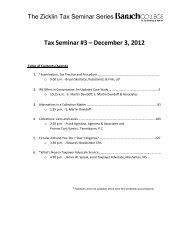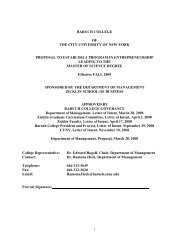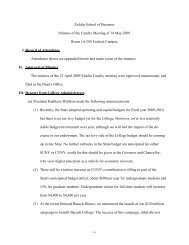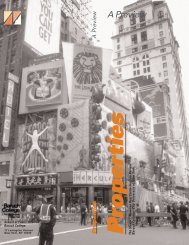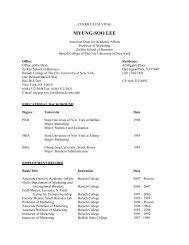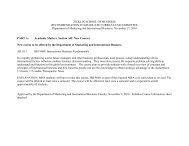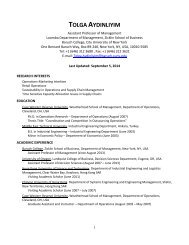Current Financial Reporting Trends
Current Financial Reporting Trends: - Zicklin School of Business
Current Financial Reporting Trends: - Zicklin School of Business
- No tags were found...
You also want an ePaper? Increase the reach of your titles
YUMPU automatically turns print PDFs into web optimized ePapers that Google loves.
The underlying reasons for changes in working capital and operating results are discussed in<br />
various locations throughout our disclosure. For example, as discussed on page 29, during fiscal<br />
2005, we substantially reduced non-cash operating expenses through reductions in depreciation<br />
and amortization of purchased intangible assets. Further, it should be noted that the aggregate<br />
changes in operating assets and liabilities did not have a significant impact on cash used in<br />
operations during fiscal 2005, as outlined in the table of consolidated cash flow data on page 29.<br />
We describe throughout management’s discussion and analysis, numerous restructuring and<br />
operating changes designed to implement operating improvements and act as underlying drivers to<br />
improved results. (See, for example, paragraph 2 on p. 23)<br />
In addition, in our discussion of liquidity and capital resources on page 31 we described the actions<br />
we took and the impact of such actions on liquidity and cash flows. We also describe the financial<br />
model we used in reducing expenses to improve our cash breakeven point.<br />
We believe when viewed together, that this disclosure provides the reader with a meaningful<br />
understanding of our financial position including the changes over the applicable periods. We<br />
believe this presentation is preferable to a detailed accounting of all changes, account by account<br />
from balances or changes from fiscal 2005 to fiscal 2004.<br />
By way of explanation to the Commission, we would point out that the consolidated balance sheet<br />
line item “other current liabilities” is comprised of accrued professional fees, accrued royalties,<br />
short-term capital lease obligations and other accrued liabilities. The use of $1.1 million in cash<br />
represents the timing of payments for these obligations and does not necessarily represent an<br />
underlying change in the business or use of cash.<br />
Segment <strong>Reporting</strong><br />
The comments related to this typically cite SFAS No. 131 Disclosures about Segments of an<br />
Enterprise and Related Information http://www.fasb.org/pdf/fas131.pdf. In all of the following<br />
examples, specific paragraphs of SFAS 131 are referenced. The comment that follows also refers<br />
to <strong>Financial</strong> <strong>Reporting</strong> Release No. 36.<br />
A review of the MD&A shows that you did not discuss the profitability measure of each segment<br />
consistent with the measure disclosed in your SFAS 131 segment information as is required by<br />
<strong>Financial</strong> <strong>Reporting</strong> Release No. 36 (Section 501.06). Please revise in future filings or advise.<br />
(Form 10-K; SIC: 4812 Radiotelephone Communications) (#701)<br />
We note your disclosure regarding your consideration of SFAS 131, and conclusion that you<br />
operate in one business segment. However, based on your discussions throughout the document,<br />
it would appear that segment reporting would be necessary, either by branch, product line or<br />
geography. Specifically, you state that each branch is responsible for its own growth and<br />
profitability, and that employees are compensated based on the financial performance of the<br />
branch. You also disclose the fact that gross profits and operating income are available for each of<br />
the branches. As such, these branches appear to meet the definition of a segment per paragraph<br />
10 of SFAS 131. Please tell us your basis for your apparent conclusion that segment disclosure is<br />
unnecessary, including your consideration of SFAS 131, or revise your disclosures accordingly.<br />
(Form 10-K; SIC: 4731 Arrangement of Transportation of Freight & Cargo) (#214)<br />
You disclose that you operate in three segments, North American packaging, international<br />
packaging and aerospace and technologies. However, in your business section and MD&A you<br />
separately discuss product lines such as North American metal beverage containers, North<br />
American metal food containers and North American plastic containers. Please tell us the factors<br />
used to identify the Company’s reportable segments and explain why you believe that North<br />
American metal beverage, North American metal food and North American plastics are not<br />
separate reportable segments pursuant to paragraphs 10-17 of SFAS No. 131. See also paragraph<br />
26 of SFAS 131. (Form 10-Q; SIC: 3411 Metal Cans) (#165)<br />
12



